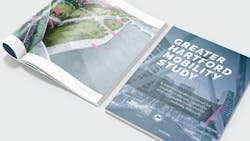CTDOT releases final report on Greater Hartford Mobility Study
The Connecticut Department of Transportation (CTDOT) has released its Greater Hartford Mobility Study final report, which outlines transportation projects and improvements in the study of Hartford, East Hartford and surrounding communities.
“CTDOT is excited to release the final report for the Greater Hartford Mobility Study. Our next steps in bringing the study’s concepts to life, including advancing several early-action projects throughout the Greater Hartford region to bring much-needed transportation mobility and safety improvements to the area within the next five years,” said CTDOT Commissioner Garrett Eucalitto. “Community involvement does not stop here—CTDOT is committed to collaborating with community partners, regional organizations and transportation stakeholders throughout the coming months and years to assess the improvements and impacts of each project as we transform what our capital region will look like for the generations to come.”
Several early action projects will be implemented within the next three to five years, improving safety and mobility for the public. Some examples of potential early action projects:
- Transforming Pulaski Circle with improved circulating sidewalks, ramps and markings for drivers and pedestrians while creating safe routes for bicyclists
- Intersection improvements on Albany Avenue and Main Street to improve safety, traffic operations and accessibility for all users
- Enhancing pedestrian facilities at highway ramps to maximize pedestrian connectivity and enhance the comfort and security of pedestrian crossings
The final report also identifies several potential mid-term action projects in the next six to 15 years, including:
- Directly connecting Route 2 to I-91 to reduce traffic weaving on the Bulkeley Bridge, improving safety and mobility for drivers
- Providing a high-quality rails-with-trail bicycle and pedestrian facility linking downtown Hartford to Bloomfield via the Hartline
- Improving evening transit service in priority areas to enhance access to employment centers for workers with non-traditional commutes and those enjoying trips for goods, services, and entertainment
The Greater Hartford Mobility Study is organized into four major program components and will undergo National and Connecticut Environmental Policy Act reviews:
- CityLink West proposes to address safety, reduce the number of ramps in the Study Core and improve connectivity between neighborhoods and green spaces/parks. Lowering the highway would link neighborhoods currently severed by the highway and create additional developable land while improving rail and bus services that share the corridor.
- CityLink East proposes to mitigate highway congestion in downtown Hartford by relocating the I-84/I-91 interchange and creating a new bridge connecting I-84 and Route 2 in East Hartford. The redesign would separate local and highway traffic and reclaim the historic Bulkeley Bridge for local traffic, including opportunities for dedicated high-capacity transit facilities, separated bike lanes and improved sidewalks.
- River Gateway proposes to connect Hartford’s central business district with the Connecticut River. It would allow for equitable access to green space, would mitigate some of the visual and noise impacts of I-91 and creates an urban boulevard to strengthen local travel options. In addition, a new bridge would connect the Sheldon/Charter Oak neighborhood with a new, river-oriented, mid-rise neighborhood in East Hartford. The bridge would prioritize bus, bicycle and pedestrian travel while accommodating automobile traffic.
- Founders Gateway proposes to consolidate the I-84/Route 2 interchange ramps in East Hartford. It would open significant acres of land to potential development and provide opportunities to strengthen the local street grid.
The Greater Hartford Mobility Study utilizes a planning process known as a Planning and Environmental Linkages (PEL) Study. CTDOT notes the Federal Highway Administration encourages PEL use since it considers environmental, community and economic goals early in transportation planning. CTDOT may adopt or incorporate Planning Products from this PEL Study into a federal or state environmental review process under Title 23 U.S.C. § 168(d)(4). The project is formally identified as State Project No. 0063-0716.
The Greater Hartford Mobility Study was launched in 2020 as a community-driven vision for creating a vibrant, equitable and sustainable multimodal transportation network. The goals of the study are to improve the movement of people and goods, increase transportation options, accessibility, reliability and safety, as well as accommodate future needs and emerging technologies, prioritize social equity and minimize environmental impacts.
